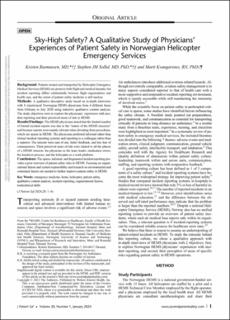| dc.contributor.author | Rasmussen, Kristen | |
| dc.contributor.author | Sollid, Stephen Johan Mikal | |
| dc.contributor.author | Kvangarsnes, Marit | |
| dc.date.accessioned | 2024-02-05T09:49:35Z | |
| dc.date.available | 2024-02-05T09:49:35Z | |
| dc.date.created | 2024-01-05T12:32:22Z | |
| dc.date.issued | 2023 | |
| dc.identifier.citation | Rasmussen, K., Sollid, S.J.M. & Kvangarsnes, M. (2023) Sky-High Safety? A Qualitative Study of Physicians’ Experiences of Patient Safety in Norwegian Helicopter Emergency Services. Journal of patient safety, 20 (1), 1-6. | en_US |
| dc.identifier.issn | 1549-8417 | |
| dc.identifier.uri | https://hdl.handle.net/11250/3115505 | |
| dc.description.abstract | Background
Patients treated and transported by Helicopter Emergency Medical Services (HEMS) are prone to both flight and medical hazards, but incident reporting differs substantially between flight organizations and health care, and the extent of patient safety incidents is still unclear.
Methods
A qualitative descriptive study based on in-depth interviews with 8 experienced Norwegian HEMS physicians from 4 different bases from February to July 2020 using inductive qualitative content analysis. The study objectives were to explore the physicians’ experience with incident reporting and their perceived areas of risk in HEMS.
Results/Findings
The HEMS physicians stated that the limited number of formal incident reports was due to the “nature of the HEMS missions” and because reports were mainly relevant when deviating from procedures, which are sparse in HEMS. The physicians preferred informal rather than formal incident reporting systems and reporting to a colleague rather than a superior. The reasons were ease of use, better feedback, and less fear of consequences. Their perceived areas of risk were related to all the phases of a HEMS mission: the physician as the team leader, medication errors, the handover process, and the helicopter as a work platform.
Conclusions
The sparse, informal, and fragmented incident reporting provides a poor overview of patient safety risks in HEMS. Focusing on organizational factors and system responsibility and research on environmental and contextual factors are needed to further improve patient safety in HEMS. | en_US |
| dc.language.iso | eng | en_US |
| dc.publisher | Wolters Kluwer Health, Inc. | en_US |
| dc.rights | Attribution-NonCommercial-NoDerivatives 4.0 Internasjonal | * |
| dc.rights.uri | http://creativecommons.org/licenses/by-nc-nd/4.0/deed.no | * |
| dc.subject | akuttmedisin | en_US |
| dc.subject | pasientsikkerhet | en_US |
| dc.subject | luftambulanse | en_US |
| dc.subject | Helicopter Emergency Medical Services (HEMS) | en_US |
| dc.title | Sky-High Safety? A Qualitative Study of Physicians’ Experiences of Patient Safety in Norwegian Helicopter Emergency Services | en_US |
| dc.type | Peer reviewed | en_US |
| dc.type | Journal article | en_US |
| dc.description.version | publishedVersion | en_US |
| dc.rights.holder | © 2023 The Author(s). | en_US |
| dc.subject.nsi | VDP::Medisinske Fag: 700::Klinisk medisinske fag: 750::Traumatologi: 783 | en_US |
| dc.source.pagenumber | 1-6 | en_US |
| dc.source.volume | 20 | en_US |
| dc.source.journal | Journal of patient safety | en_US |
| dc.source.issue | 1 | en_US |
| dc.identifier.doi | 10.1097/PTS.0000000000001172 | |
| dc.identifier.cristin | 2221369 | |
| cristin.ispublished | true | |
| cristin.fulltext | original | |
| cristin.qualitycode | 1 | |

